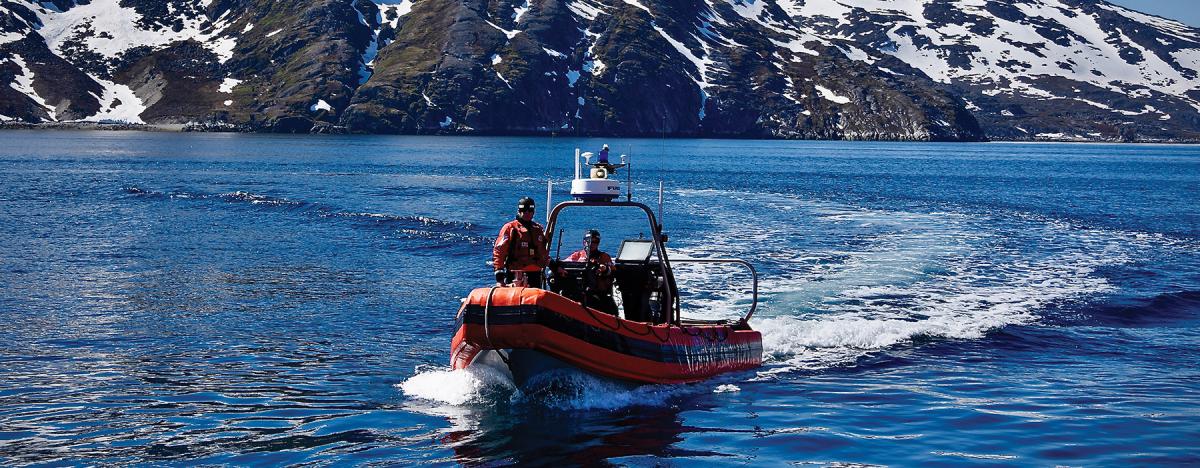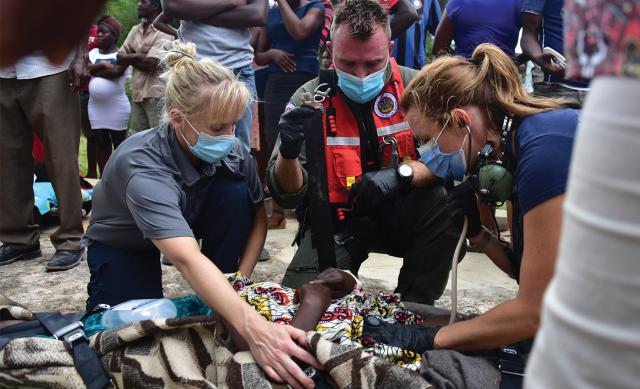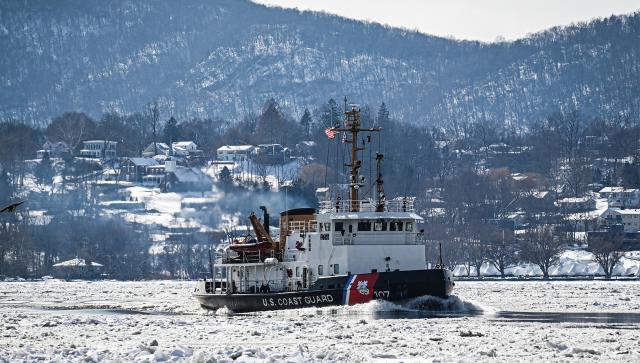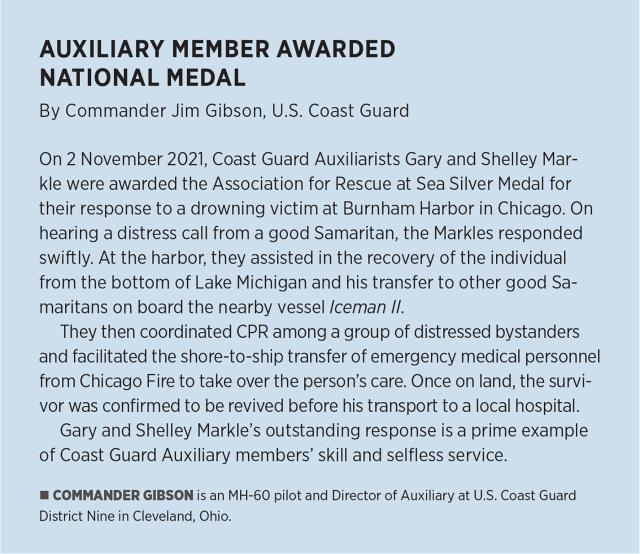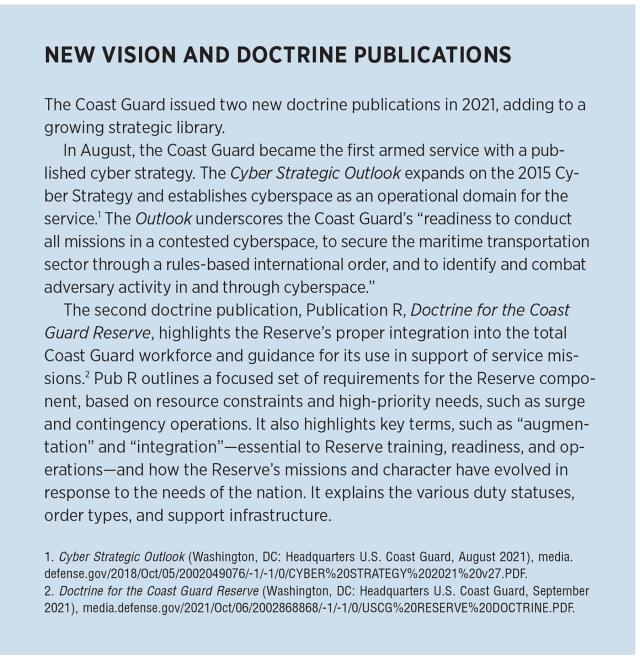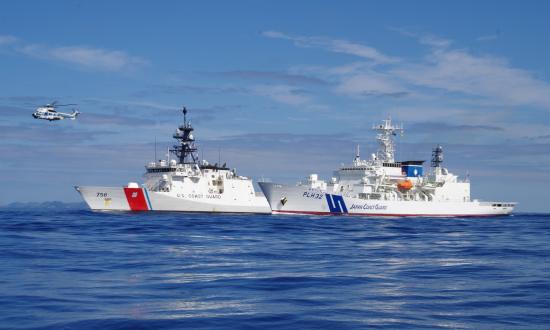In 2021, the U.S. Coast Guard continued the significant operational tempo it has seen over the past few years, both within the United States and overseas. The demand for its services and support remained high—consider, for example, that District 17 has a large portion of the Arctic in its area of responsibility, and District 14 includes the Indo-Pacific region. In his annual State of the Coast Guard address, Commandant Admiral Karl Schultz highlighted the service’s unique role: “We bring a range of maritime capabilities to bear across what I like to refer to as the cooperation-competition-lethality continuum,” he noted. “While we train and operate across the entire continuum, it is in the cooperate and compete areas where we thrive and best demonstrate our value to the nation.”1
The Coast Guard played a role in multiple significant national and international events throughout the year. The Seattle-based medium polar icebreaker USCGC Healy (WAGB-20) completed a historic deployment north to the U.S. Arctic, through the Northwest Passage, south along the U.S. East Coast, through the Panama Canal, and back home to Seattle—a rare circumnavigation of North America. The Healy projected U.S. sovereignty in the Arctic while performing critical scientific missions such as seafloor mapping and analysis of the ocean fate of meltwater from Greenland’s glaciers. In addition, the Coast Guard’s only operational heavy icebreaker, the USCGC Polar Star (WAGB-10), completed an 80-day U.S. Arctic deployment—the first winter Arctic deployment in nearly 40 years, developing future Arctic sailors and gathering high-latitude scientific data.
The Coast Guard’s ability to quickly and effectively respond internationally was on full display following the magnitude 7.2 earthquake in Haiti on 14 August. The service deployed helicopters, fixed-wing aircraft, cutters, and crews to forward operating locations surrounding Haiti to support humanitarian relief efforts, the U.S. Agency for International Development (USAID), and U.S. Southern Command’s Operation Enduring Promise. By the end of August, the Coast Guard had flown 262 sorties, completed 381 medical evacuations, and transported more than 34,600 pounds of disaster and relief supplies to strategic locations.2 With the most urgent and immediate transportation needs answered, humanitarian aid and disaster relief mission workers were able to focus on sourcing assets and logistics for the extended mission of assisting the people of Haiti. Coast Guard crews ran missions for nearly a month.
Last year also tied 2020 as the third-busiest Atlantic hurricane season on record. Making landfall in Louisiana on 29 August, Hurricane Ida, the second major storm of the season, was the fifth-strongest on record in terms of wind speed. Ida left more than a million people in the Coast Guard’s Eighth District without power for several weeks and triggered tornadoes and flash flooding, shutting down nearly 95 percent of the region’s crude oil and gas production. The Coast Guard worked nonstop, assessing about 2,500 reports of pollution spills, restoring aids to navigation, evaluating waterways damage, and removing obstructions.3 More than 90 percent of these actions were completed just two months following the disaster.
Law Enforcement
The national news covered multiple Coast Guard interdictions of illicit narcotics. One case that stands out occurred in July, when the USCGC Joseph Tezanos (WPC-1118) intercepted 502 kilos of cocaine, valued at more than $15 million, from a 24-foot “go-fast” near Puerto Rico. As with many interdictions, it was a joint effort: A Customs and Border Protection (CBP) aircraft crew did the initial detection, and the bust was a coordinated action supported by the cutter, the U.S. Attorney’s office, CBP, and the Caribbean Corridor Strike Force.4
In the spring of 2021, Coast Guard Sector Columbia River worked with agents from CBP and National Oceanic and Atmospheric Administration (NOAA) fisheries law enforcement teams to stem the use of paper captains in the commercial tuna fishing fleet operating out of Washington state. “Paper captains” are individuals listed on documents as captains of U.S.-flag vessels but who in actuality serve as deckhands or in similar lower-level roles while foreign nationals direct operations. Under U.S. law (46 USC §12131) a documented vessel—one registered by the federal government through the U.S. Coast Guard—must be under the command of a U.S. citizen.
CBP and NOAA agents and District 13 law enforcement personnel have investigated eight paper captain violations in the Pacific Northwest since 2019. One Washington-based tuna fishing fleet paid $9,150 in civil penalties and received citations for $140,000 in additional fines still pending adjudication.
Marine Safety and Waterways Management
The marine safety mission ranges from pollution response to commercial ship inspection to waterways management. In October, the Coast Guard worked with multiple federal, state, and volunteer agencies to respond to the Pipeline P00547 Incident oil spill off the coast of Orange County, California. Approximately 25,000 gallons of oil were released, affecting about 120 miles of shoreline from Newport Beach to the U.S.–Mexico border. The Coast Guard acted as the federal on-scene coordinator throughout the response. Efforts continue, but as of late November 2021, the recovery included the removal of 5,544 gallons of crude oil by vessel and approximately 542,000 pounds of oily debris from shorelines, and 24 birds were cleaned and released. The timely response by the Coast Guard and partner agencies helped minimize the environmental impact of the spill along California’s coastline.
Another example of marine safety engagement involves commercial vessels on the Great Lakes that enter a layup period for steel repair and maintenance each winter. Many firefighting safety systems are disabled during layup, and crews depart the vessel after winterization, leaving a shipkeeper to monitor the vessel. There have been two significant fires on board vessels in winter layup in the past three years. The M/V St. Clair in Toledo, Ohio, in 2019 was a total loss, and fire on the freighter M/V Roger Blough in Sturgeon Bay, Wisconsin, in 2021 caused more than $20 million of damage.5 With input from industry, fire departments, and the National Transportation Safety Board, the Coast Guard developed guidance recommending a risk assessment be conducted to establish a winter layup plan. The Coast Guard formed a working group to develop further guidance for mitigation techniques and strategies to reduce the risk of catastrophic fires.
October saw the site selection for a new National Center of Expertise for Oil Spill Preparedness and Response. This unique center, authorized by the Frank LoBiondo Coast Guard Authorization Act of 2018 and expected to open in 2022, will be headquartered in Michigan. Lake Superior State University in Sault Ste. Marie will serve as the center’s hub and home to its supervisor, the Great Lakes Environmental Research Laboratory in Ann Arbor. The center will examine the impact of oil spills in freshwater, develop new technologies and equipment for responding to oil spills in the Great Lakes, and train first responders.6
Waterways management takes a unique turn in the winter in locations such as New England. The Coast Guard’s domestic ice-breaking forces receive little national attention, but they are unsung heroes. For example, in 2021, within the 140 nautical miles between New York City and Albany, the Coast Guard recorded 1,550 hours of ice-breaking. This effort was part of the service’s annual Operation Reliable Energy for Northeast Winters, which facilitates the safe movement of 475,000 tons of dry cargo and 8.3 million barrels of heating oil from New York to Maine.7
Search and Rescue
The Coast Guard’s best-known mission is search and rescue (SAR). In fiscal year 2021, there were 16,403 cases with 4,746 lives saved. A few events stood out, particularly in that some were inland or over-ice rescues. This type of SAR does not get the recognition open-ocean work does.
Hiker rescue cases set the tone for District 13 in 2021. On 20 January, Coast Guard Sector North Bend and partner agencies rescued two hikers, including one who had fallen down a cliff, near Grayback Mountain in Medford, Oregon. Petty Officer First Class Trevor Salt, a rescue swimmer, spent 12 hours rendering lifesaving medical care until he and the hikers were able to be hoisted by the Oregon Army National Guard on board a UH-60 Blackhawk helicopter the following morning. Salt was named Military Times Coast Guardsman of the Year 2021 and received the Angels of the Battlefield award from the Armed Services YMCA.8
The Grayback Mountain rescue was the first of five major cases in 2021 involving inland search and rescue. Fortunately, rescue swimmers in the Pacific Northwest develop and carry out unique training evolutions focused on inland SAR, overnight patient care, and terrain navigation.
Open-ocean SAR also was widespread in 2021. On 2 March, Canada’s Halifax Joint Rescue Coordination Center notified the Coast Guard First District Command Center that the 143-foot fishing vessel Atlantic Destiny was disabled, on fire, and taking on water 115 miles south of Nova Scotia. The response was immediate and significant. A Coast Guard Air Station Cape Cod HC-144 fixed-wing crew and two MH-60 Jayhawk helicopter crews launched and arrived on the scene to assist. Enduring gale-force winds and 26-foot seas, a Royal Canadian Air Force CH-149 Cormorant helicopter crew from 14 Wing Greenwood in Nova Scotia hoisted six mariners from the vessel and dropped off two SAR technicians to assist in dewatering. A Canadian CC-130 Hercules fixed-wing crew, also from 14 Wing Greenwood, provided top cover for the mission, managing communications on scene and serving as a backup rescue resource. The U.S. Jayhawk crews hoisted 21 mariners. The remaining four mariners and the two SAR technicians moved to the CCGS Cape Roger, a Canadian fisheries patrol vessel. The Atlantic Destiny eventually sank.9
In Green Bay, Wisconsin, the Coast Guard led a multiagency SAR response to rescue 66 people stranded across several ice floes perilously drifting away from shore. With temperatures plummeting to near zero and a significant winter storm looming, Coast Guard forces from Sector Lake Michigan, Station Sturgeon Bay, Air Station Traverse City, and the USCGC Biscayne Bay (WTGB-104) came together for the rescue operation. The event highlighted the service’s specialized ice rescue techniques and gear and its newest airboat, the Special Purpose Craft–Ice Rescue Transport, which were employed to rescue all 66 people.
Finally, District 17 gets the award for the “coolest” SAR-related event. In September, two staff members conducted an international SAR exercise on board a French vessel at the geographic North Pole. The exercise simulated a fire-prompted abandon-ship drill onto the ice. Sixty-seven volunteer passengers and crew participated and remained on the ice pack for 24 hours to test the ship’s polar survival plan and equipment and emergency communications capabilities with international Arctic rescue coordination centers.10
New Fleet Cutters and Aircraft
The Coast Guard continues to add 154-foot Sentinel-class fast response cutters (FRCs) to replace the aging 110-foot Island class. The FRCs carry the names of enlisted Coast Guard heroes, and the 45th unit, the USCGC Emlen Tunnell (WPC-1145), is notable. This cutter celebrates the accomplishments of First Class Stewards’ Mate Emlen Tunnell, who saved the lives of two shipmates. During World War II, in 1944, he rescued a shipmate engulfed in flames after a Japanese torpedo blew a hole in the USS Etamin (AK-93). In 1946, he dove into Newfoundland’s icy waters to save a shipmate who had fallen from the USS Tampa (WPG-48). Following his heroic wartime service, Tunnell went on to play in the National Football League for both the Green Bay Packers and New York Giants. He won league championships with both teams. But his accomplishments did not end there. In 1967, he became the first African American to be elected to the Pro Football Hall of Fame. The Emlen Tunnell will be home ported in Manama, Bahrain, part of U.S. Coast Guard Patrol Forces Southwest Asia.11
The new Heritage-class offshore patrol cutters (OPCs) are getting closer to delivery. The first, the USCGC Argus (WMSM-915), is nearing completion; the Chase (WMSM-916) has an authenticated keel, and the Ingham (WMSM-917) had its steel cutting in September in Panama City, Florida. The new cutters replace the current 210-foot medium-endurance cutter fleet.
Within aviation, Coast Guard Air Station Borinquen in Puerto Rico transitioned from MH-65 Dolphin helicopters to the MH-60 Jayhawk. The Jayhawk provides greater range, longer on-scene endurance, and increased payload capacity, enabling the Coast Guard to respond more efficiently to natural disasters and crises. The Borinquen transition brings the current count of MH-60s in the service to 48.
Finally, progress continues on the polar security cutter to replace the aging icebreaker fleet. “The Coast Guard operates our nation’s only icebreaking fleet countering malign influence as our nation’s most persistent surface military presence at the polar regions,” Admiral Schultz said. “We do this with just two cutters, one heavy and one medium icebreaker. This is a woefully unacceptable level of presence in an area where we must be a leading force.”12 Delivery date has been delayed to 2025, one year later than the original contract delivery schedule.
International and DoD Engagement
International engagements were prevalent throughout the year. The Legend-class USCGC Hamilton (WMSL-753) escorted the first two FRCs on the transatlantic leg of their voyage to their new home port in Bahrain and completed joint operations in the Mediterranean and Black Seas with maritime components from Italy, Georgia, Ukraine, Malta, Turkey, Romania, and Bulgaria. The Hamilton is the first cutter to visit the Black Sea since 2008. Coast Guard operations with the U.S. Sixth Fleet demonstrate the service’s commitment, flexibility, and capability to operate and address security concerns throughout Europe and Africa. They also reflect its commitment to the triservice maritime strategy Advantage at Sea.
The USCGC Munro (WMSL-755), a California-based Legend-class cutter, completed numerous events underscoring the service’s international role. The crew completed the first-ever U.S. Coast Guard–U.S. Navy bidirectional transit, passing the USS Kidd (DDG-100) port to port in the Taiwan Strait.13 The Munro also operated with several regional governments, navies, and coast guards. The cutter was the first to visit Vietnam since the United States and Vietnam established diplomatic relations in 1995.
In the Indo-Pacific, multiple surface and air assets deployed from Coast Guard Pacific Area and District 14 to execute Operation Blue Pacific. Eleven surface assets deployed for a combined total of 462 days, patrolling 3.28 million square nautical miles. Air Station Barbers Point crews flew some 58,600 miles, with additional miles covered by uncrewed ScanEagle drones. Operation Blue Pacific establishes a presence within the region, in part using 11 bilateral shiprider agreements with Pacific Island Forum nations to help curb illegal, unregulated, and unreported (IUU) fishing on the high seas and within partner nations’ exclusive economic zones. “IUU fishing has replaced piracy as the leading global maritime security threat,” Admiral Schultz noted. “If IUU fishing continues unchecked, we can expect a deterioration of fragile coastal states and increased tension among foreign-fishing nations, threatening geopolitical stability around the world.”14
In addition, with the increased accessibility of the waters of the Chukchi Sea and the U.S. Arctic, competitors are maneuvering for advantage. The Coast Guard continues to be a primary maritime mechanism of national sovereignty in the region, as evidenced by recent patrols by the USCGC Midgett (WMSL-757) and Kimball (WMSL-756). While patrolling the maritime boundary line through the Bering Strait and into the Chukchi Sea, they projected a professional U.S. presence and upheld international maritime norms.
With little notice, District 17 tasked the Kimball and Bertholf (WMSL-750) to monitor a Chinese task group on patrol in the Bering Sea and south of the Aleutian Islands. Working together under District 17 tactical control, with the U.S. Indo-Pacific Command and Pacific Fleet, Midgett, Bertholf, and Kimball demonstrated the Coast Guard’s ability to conduct operations in one of the world’s most remote and challenging maritime environments, directly supporting the National Security Strategy, the triservice strategy, and the Coast Guard’s Arctic Strategic Outlook.
On the opposite side of the globe, the Coast Guard participated in the Danish Joint Arctic Command’s annual Exercise Argus in southern Greenland. The USCGC Maple (WLB-207), a 225-foot Juniper-class seagoing buoy tender, participated with HDMS Ejar Mikkelsen, a Royal Danish Navy patrol vessel, and FNS Fulmar, a French coastal patrol vessel. Rear Admiral Keith Smith, Deputy Commander, Coast Guard Atlantic Area, stated:
This exercise builds partner capacity and expertise in search and rescue, incident management, and, for the first time, marine environmental response. Cooperation plays a pivotal role in building robust search and rescue capacity and maritime response. Building expertise for SAR operations in the Arctic and strengthening relationships is vital to ensure the safety and well-being of all mariners in the High North. It also provides for mission capacity growth and future force readiness.15
In August, the service participated in Operation Nanook, an annual Canadian whole-of-government exercise. The event offers an opportunity to engage with the Canadian Armed Forces and a range of Canadian government agencies to advance shared maritime objectives, enhance critical partnerships, and deter near-peer competitor Arctic influence. The 270-foot Famous-class USCGC Escanaba (WMEC-907), Sentinel-class USCGC Richard Snyder (WPC-1127), and tactical unit Maritime Security Response Team members worked with crews on the Royal Canadian Navy’s HMCS Harry DeWolf and Goose Bay, as well as the Canadian Coast Guard’s Pierre Radisson. This exercise was the farthest north Atlantic Area has sent a Sentinel-class cutter.
People and More
Diversity and inclusion efforts continue to be a service priority. Admiral Schultz testified before the U.S. House of Representatives Committee on Homeland Security on achieving diversity, equality, and accountability within the service.16 He explained that the service’s Diversity and Inclusion Action Plan (DIAP) formalizes the Coast Guard’s continued dedication to assessing and developing policies, procedures, and workforce training to help drive organizational change and promote more inclusive behaviors. The service has trained and deployed 125 diversity change agents to provide diversity and inclusion training, coaching, and support to the total workforce; provide command cadre coaching and counsel; and foster of an organizational culture that values respect, diversity, and inclusion.
In January, Coast Guard personnel from several District Five units and the Deployable Special Forces community came together with federal, state, and local partners to monitor the waters around the Potomac and Anacostia rivers in Washington, D.C., for the 59th presidential inauguration. People and relationships are what make these complicated joint operations possible. “This is what they train for; this is one of those things that they look forward to participating in,” said Captain Joseph Loring, Sector Commander of Maryland–National Capital Region of the Coast Guard.17 The Coast Guard was ready to respond to more than just a boat venturing into restricted waters. Several specialized teams, including the Atlantic Strike Force, were standing by, ready to respond to a possible weapons of mass destruction threat.
In a smaller but no less important action, Petty Officer Second Class Jennifer Williamson of Station Wrightsville Beach, North Carolina, was off duty at a local beach when she noticed swimmers in distress. She grabbed a stranger’s boogie board and ran into the water to save three men caught in a riptide. “I think that anyone in the Coast Guard would have reacted the same way that I did. That’s just what we do in our service,” she said.18
So, another busy year. What can be expected in 2022? A new Commandant will take the helm, human capital challenges will continue, new assets will come on line, COVID-19 will linger, and the service will continue to respond to the growing threats posed by rising seas and more severe storms.
1. ADM Karl L. Schultz, USCG, “State of the Coast Guard 2021,” 11 March 2021.
2. U.S. Agency for International Development, “Haiti—Earthquake Fact Sheet #10, September 2, FY 20201.”
3. James Bruggers, “After Ida, Louisiana Struggles to Tally the Environmental Costs,” Inside Climate News, 24 September 2021.
4. U.S. Coast Guard, “Coast Guard Offloads $15 Million in Seized Cocaine,” news release, 13 July 2021.
5. Casey Conley, “Great Lakes Bulk Carrier Seriously Damaged by Fire during Layup,” Professional Mariner, 1 April 2021.
6. Office of Senator Gary Peters, “After Being Enacted into Law by Peters, Great Lakes Coast Guard Center of Expertise to Be Headquartered in Michigan,” news release, 19 October 2021.
7. U.S. Coast Guard, “Coast Guard Continues Ice-Breaking Operations throughout Northeast,” news release, 2 February 2021.
8. Diane Stancy Correll, “Coast Guardsman of the Year 2021 Helped Save the Lives of Two Hikers,” Navy Times, 25 August 2021.
9. Chris Thatcher and Dan Parsons, “Atlantic Destiny,” Vertical magazine, 20 May 2021.
10. “Alaska Coast Guard Joins North Pole Rescue Exercise,” KINYradio.com, 7 October 2021.
11. “Coast Guard Commissions Fast Response Cutter Emlen Tunnell,” Coast Guard News, 15 October 2021.
12. ADM Karl L. Schultz, USCG, “State of the Coast Guard 2020,” 11 March 2021.
13. U.S. Seventh Fleet, “U.S. Navy, Coast Guard Transit Taiwan Strait,” news release, 27 August 2021.
14. U.S. Coast Guard, Illegal, Unreported, and Unregulated Fishing.
15. SCPO Sara Muir, USCG, “U.S. Coast Guard Participates in Exercise Argus, Strengthens Arctic Partnerships,” DVIDShub.net, 1 July 2021.
16. ADM Karl L. Schultz, USCG, “Building the Coast Guard America Needs: Achieving Diversity, Equity, and Accountability within the Service,” testimony before the House Committee on Homeland Security, 23 June 2021.
17. Mike Murillo, “How the Coast Guard Is Helping Secure the Presidential Inauguration,” WTOP.com, 19 January 2021.
18. Petty Officer First Class Travis Magee and Petty Officer Third Class Emily Velez, “Video: Off-Duty Coast Guard Member Rescues 3 Men,” DoD News, 11 August 2021.



